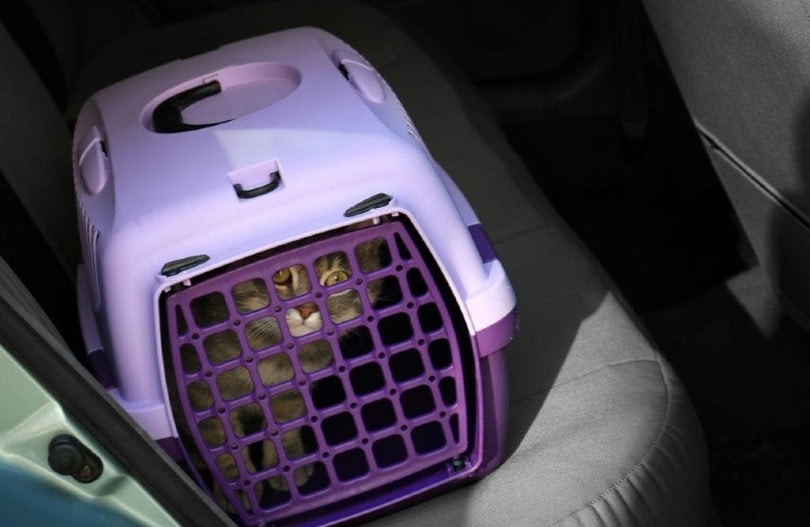
Click to Skip Ahead
Crate training your cat might seem like an odd concept. After all, unlike puppies, cats are wizards for being able to use the bathroom where they should after the first few introductions to the litter box.
And since cats are less destructive, they can also usually be left unattended in the home without their owners for several hours at a time. So when does crate training come in handy, and how do you get them used to confinement? We’re going to go over all of that in this article.
The 7 Tips for Crate Training a Cat
1. Let Your Cat Sniff Around
Before you try to place your cat inside any enclosure, it’s best to let them get a little acclimated with it first. Open up the door of the kennel, crate, or carrier. Let them sniff around! If they climb inside, this is a great sign! It might go a lot smoother than you think.
Naturally, you won’t want to slam the door shut and make them stay inside if they enter. You’ll want to really warm them up to the idea first. If you create a bad experience when introducing the crate, they might always associate it with negative things.
It’s important to differentiate a crate, sometimes also referred to as a cage or a kennel (more often a term used at the vets), from a cat carrier. A kennel can also be a boarding facility for cats or a cattery. A cat carrier, on the other hand, or a cat box, is a small carrier used to transport cats usually to the vets or another short distance. They have enough room to comfortably fit your cat but no room for a litter box and are not meant to be used for a longer journey.

2. Use Treats to Incentivize
Once they have shown interest in the crate, it’s time to give them a little motivation. Drop a few treats inside and let them go scout them out. Once they are inside, you can drop a few more in to get them comfortable.
You shouldn’t shut the door at this time. As with the above statement, shutting the gate the first time inside might give them some anxiety and make it harder to get them in the crate in the future. Instead, continue training with treats and even toys by throwing them inside and motivating your cat to follow them in, so they associate the crate with food and fun. This first step in training may take weeks or longer for some cats, but it is crucial.
3. Use Positive Language
Use positive language when your cat is in the crate. Keep a high-pitched, relaxed voice that is very reassuring. Try to use only one word to relate to the crate itself. You could use a word like “house” or “crate” so they can always relate the word with the placement.
Never make the crate seem like a punishment. It would be best if you never put your cat in a crate when they have done something that you don’t like. If they begin to associate the crate with punishment, it can create a fear-based relationship with the experience itself. That could make persuading them to go into the crate significantly harder for other reasons.

4. Close the Door
After they’ve been in and out quite a few times on their own, or even better, after they have decided to relax on the bed in the crate or eat a meal in there, you can then try to close the door. You can still drop treats from an opening while cheering them on. You don’t have to leave them in there for long intervals of time. Close the door for a few minutes and open it again to free them.
5. Make the Crate Cozy
Make the crate a warm and inviting place to be. Put a comfy bed in, their favorite blanket, a few toys, and some snacks! Whatever it takes to make them associate the cage with some quiet and desired alone time opposed to isolation and punishment.

6. Monitor While Home
Before you try to take them on a trip or leave them alone, monitor them in the crate while you’re home. Leave them in there for 5 to 10 minutes with you in the room. You can let them out and try again on your chosen time schedule.
Keep in mind that every cat will be different. Some of them won’t mind being in the crate for a bit, while others will cry to get out. So keep in mind that each one will acclimate differently.
7. Continue With Small Steps
Now that your cat is happy entering the crate and spending some time in there with the closed door, slowly increase the amount of time you keep them in their crate. Initially stay in the room and continue observing them, but slowly start leaving them on their own for 15 minutes at a time. You can use a pet monitor camera to see what they’re up to. It may be normal for most cats to meow or try to scratch at the door at first, but they should settle promptly. If they are distressed, you may need to take a step back and let them out.

 Why You Should Crate Train Your Cat
Why You Should Crate Train Your Cat
Crate training your cat comes in handy for a variety of reasons. Some of which include:
Unlike dogs, cats typically don’t have to be created when you’re gone for long hours working. They are more than capable of using the bathroom where they are supposed to and not chewing up all of your things. However, there are times when they do need to be confined.
If they are already used to the crate, it can alleviate many anxieties associated with confinement.
The 3 Types of Crates and Carriers for Cats
There are several different kinds of crates, kennels, and carriers for cats. Here are the most common ones, and we will look at some carriers as well to explain the difference and avoid confusion.
1. Wire Kennels

Wire kennels can be used for cats or dogs. They generally have a bottom tray and latched doors. Some of them only have one door facing to the front, while other ones have multiple entry points. You can keep a litter box and other goodies inside if you get a large enough kennel. These crates are generally used for indoor retention and not for travel.
If you want something that will keep your pal busy for a while, they even make multiple-tier cat towers that keep your kitty safe inside. You can furnish it with hammocks and beds, scratching posts, and other activities.
Some cats may try to chew at the wire and get their teeth, jaws, or paws stuck in the mesh or even damaged, so be mindful of this and monitor your cat.
2. Plastic Crates and Carriers

Plastic crates are generally used for travel, as they are not collapsible like wire ones, meaning they are safer for car journeys. Some airlines also accept these for flights. Plastic makes it easier to clean, but it may be a bit harder to provide good visuals of your cat. This may be more appropriate for nervous cats that like to hide. Depending on size and spaciousness, they can also be appropriate crate options for home and should be large enough to fit a bed, litter box, food and water bowls, and toys.
Some people may think of a cat carrier instead, but they are much smaller and can only fit your cat, meaning they have a different purpose than a crate. There is no room for a litter box or any extras. They are meant to transport your cat to the vet or to take another short-distance trip. These types of crates usually have two plastic pieces that fit together with a top handle. For most smaller carriers, there is a door in the front.
3. Mesh Carrier

Mesh carriers are used for travel and not much else. Sometimes these carriers can have extensions to give your cat a little more space during travel time. You might also see features such as large mesh windows that you can cover if you need to give your cat more privacy.
Since these carriers are generally designed for travel, some also might have features like seat belt attachments to keep them safe in the car. Since they are made of mesh and fabric, they are not strong enough for extended use.
Long-Term Confined Spaces
If you want something that gives you the freedom to leave your house for long periods while your cats are entirely safe, there are several ideas. As we mentioned above, you can buy a multi-tier cat kennel for indoor use.
However, if you want them to have a more natural option, you can also build your cat a sanctuary or catio at your home. This idea might not work for apartments or rental spaces, but it can be an excellent option for homeowners.
You can build a substantial cat sanctuary off of a window. Many options to create this space can be hard to do on your own. DIY options on sites like Pinterest will give you step-by-step processes to create an outdoor space that your cat can enjoy.
These enclosures must be completely secure, and you should have adequate shelter to keep your cat out of the elements.

Conclusion
So, now you know how to warm your cat up to the idea of staying in a crate for a little while. If you plan on leaving your cat in their crate for long periods, we recommend getting a multi-tier cat kennel and giving them plenty of things to do while in confinement!
If your cat really enjoys being outside, you can even build them their very own catio to freely allow them access to inside and out. Getting your cat used to a crate may be handy if they will stay at a boarding facility or the vet’s office, or if they need to be crated for recovery after illness or surgery.
Featured Image Credit: Okssi, Shutterstock



 Why You Should Crate Train Your Cat
Why You Should Crate Train Your Cat



